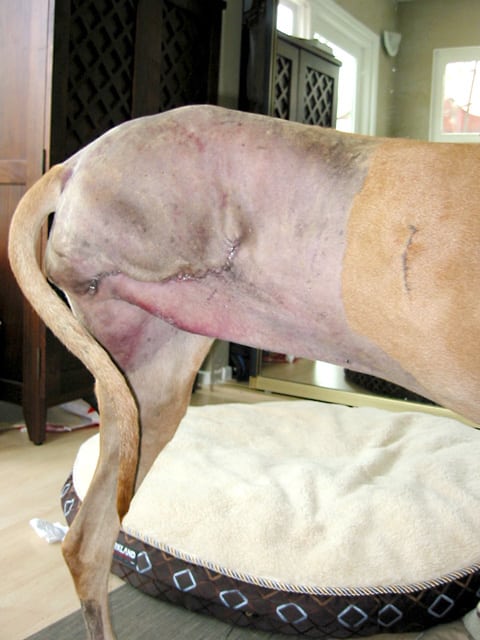Last November we had a live chat with board-certified veterinary oncologist Dr. Michael Lucroy. During the chat, a member asked him about a canine cancer study which concluded that removing the primary cancer site will actually make cancer metastasize faster.
 The member wondered if we do amputate, aren’t we still in a no-win situation?
The member wondered if we do amputate, aren’t we still in a no-win situation?
At the time, Dr. Lucroy didn’t have the study on hand, so we followed up with him recently and here’s what he said:
“I think your member is thinking about a study done several years ago (Pirie-Shepherd SR, Coffman KT, Resnick D, et al. The role of angiostatin in the spontaneous bone and prostate cancers of pet dogs. Biochem Biophys Res Commun 2002 292(4):886-91.) as a collaboration between researchers in Boston and Purdue University.
The researchers were studying angiostatin, which is a potent inhibitor of angiogenesis (development of new blood vessels). Because cancer requires nutrition to grow, it must recruit the growth of new blood vessels in order to grow beyond a handful of cells. The researchers discovered that the urine of dogs with osteosarcoma contained angiostatin fragments. Once the primary tumor was completely removed (by amputation) the angiostatin fragments were no longer detectable.
The theory is the primary tumor keeps the metastases in check. Clinically, we observe that very few dogs have metastasis visible on chest x-rays at the time of diagnosis, but if we we examine lung tissue there are osteosarcoma cells detectable under the microscope. After amputation, if nothing else is done, these micrometastases start to develop quickly. The results of this study provide the biological mechanism to explain our clinical observations.
 But it is important to note that although we cannot see them with chest x-rays, microscopically the metastatic event has already occurred. So removing the primary tumor does not cause the cancer to metastasize faster, but simply allows the metastatic sites already present to start to grow.
But it is important to note that although we cannot see them with chest x-rays, microscopically the metastatic event has already occurred. So removing the primary tumor does not cause the cancer to metastasize faster, but simply allows the metastatic sites already present to start to grow.
Occasionally we have dog owners who are aware of this research and suggest we simply leave the bone tumor in place. Ethically, however, we cannot do this if we want to relieve suffering. Bone cancer is very painful, and we cannot easily control chronic pain.Therefore we are obligated to either amputate the affected leg or treat the tumor with radiation therapy and pamidronate to relieve the pain.
We now know that by doing this, we are removing the source of angiostatin – which inhibit the growth of the micrometastases. So, enter chemotherapy to slow the growth of these metastatic sites.”
Many thanks to Dr. Lucroy for taking the time to answer this valid question.
 Join the forum discussion on this topic!
Join the forum discussion on this topic!